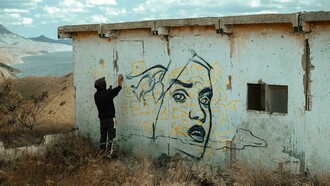The Royal Academician John Carter1 is one of those guys who seems to have been around forever, widely respected but really best known to the English painting/sculpture cognoscenti, rather than a figure of international populist appeal.
The reasons for this are complex, but as my title implies, we are in a very particular time, both politically and artistically, where the prevailing media narratives derive their dynamics more from the operatics of soap rather than La Bohème. If my observation borders on the churlish I apologise, but it is borne from some 30-odd years’ worth of experience of galleries, artists, museums, dealers, students, teachers - and all points south.
My viewing of Carter’s work had the fortune to catch me on a day when I had begun to really grasp that, for artists aged 30 or less, the past really is a foreign country. Picture, if you will, a scene at Hayward, or Tate, The Turner Prize, Venice Biennale pavilion, Gagosian, The Royal College of Art, whatever, where the latest pseudo social science narrative is portrayed with requisite ugly awkwardness by the latest Arts Council Collection-acquired youth project. Since the procession of post-movement movements, (Conceptual Art, the YBA’s, ‘Banksyism’ etc.), the truth is that art teaching has really struggled (and perhaps failed) to reconcile art history with the art present. We must reluctantly entertain the idea therefore that the two have possibly become irreconcilable from more than one perspective.
Further to this, I would say that there is evidence that, in a way analogous to the ‘big bang’ theory of the continuously expanding universe, the history of art, with all its aesthetic and religious associations, seems to be continuing to move even further away from our understanding. Without wishing to labour this, the diminution of art history finds its corollary in the insatiable ‘black hole’ plethora of culture vehicles that swallow everything to comprise the mystical activity, a.k.a ‘contemporary practice’.
My biggest beef is with a western arts academia in the guise of faculty, that have stood by and, through inaction and intellectual laziness, presided casually over the incidental demise of aesthetics. This has inadvertently condoned topicality and autobiography to the extent that teaching in many former art schools, now faculties, has headed moth-like, towards the flaming non-pedagogy of responsive counselling, embodied by the individual tutorial.
So, what on earth has this rant gotten to do with poor old John Carter I hear you ask? Well actually everything. Carter’s work is exquisitely made, drawn, shaped, formed, coloured, scumbled, textured, grained and presented. There is a genuine delight in the unspoken word, the finesse and poise of the shape, the prowess of the choice of colour. But in one generation or less, nobody will get it; Let’s not kid ourselves, composition, perspective, chromatic theory and Gregory’s Eye and Brain are from and for the past and will recede in a way that the renaissance and its endless representations will not. And maybe of course Darwin had a point, we only retain, as a species, what we need to know, essentially to survive. The fact is that contemporary artists don’t really need to grasp these classical issues through studentship or apprenticeship, the digital world and mobile devices and dye sub. and 3D printing render such knowledge superficially redundant.
So, I write this knowing that the audience capable of appreciating Carter’s art are probably of a certain generation (I include myself of course). I so hope I am wrong, but my prediction is that by 2030 presenting work that is to be understood through visual literacy will be as casting pearls before swine.
It is, however, quite brilliant of its type.
1 John Carter, On Paper: Surface and Structure. Redfern Gallery, London. 5 June - 30 August 2019.















